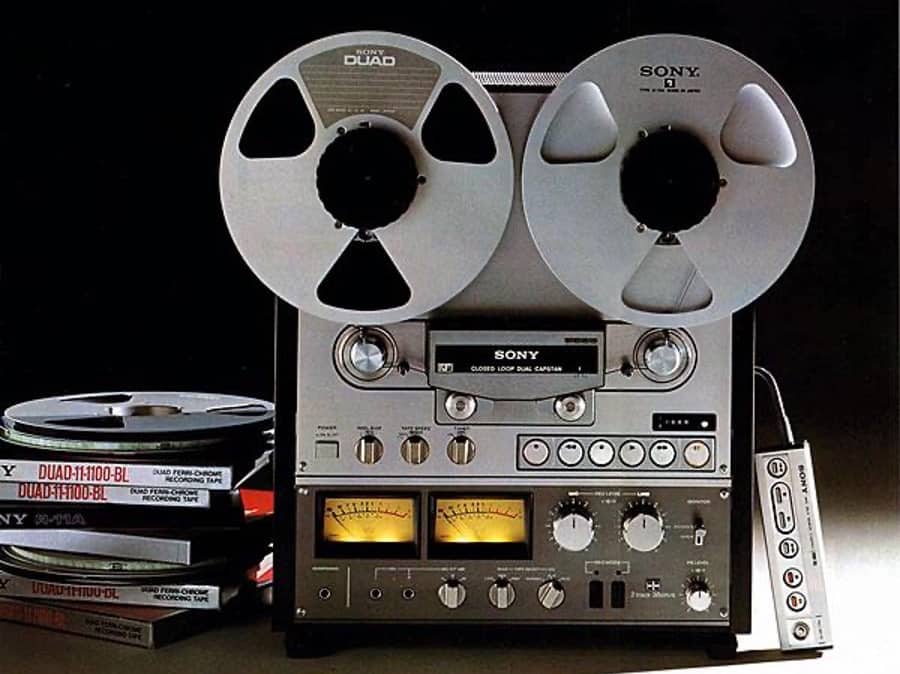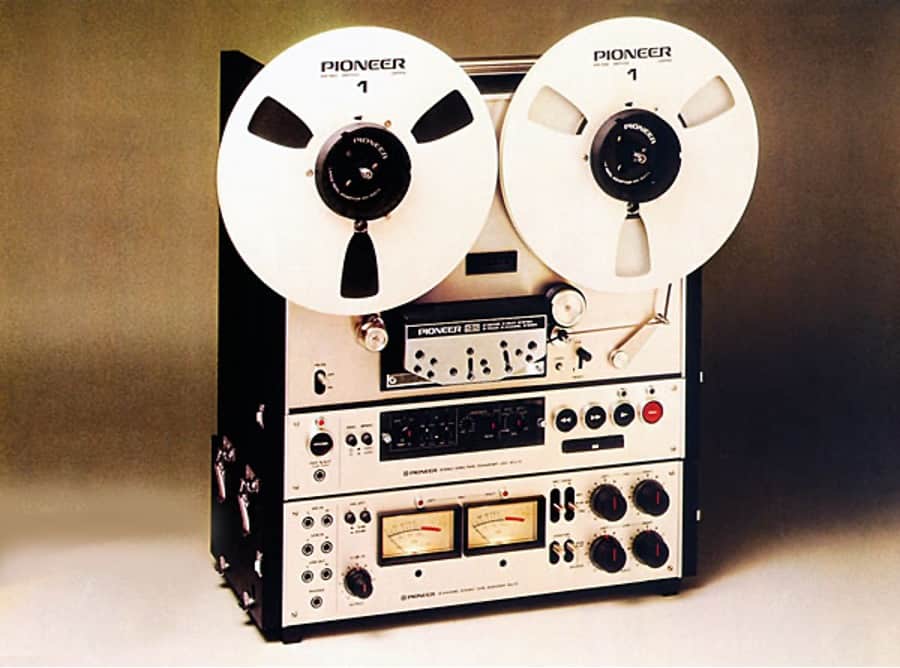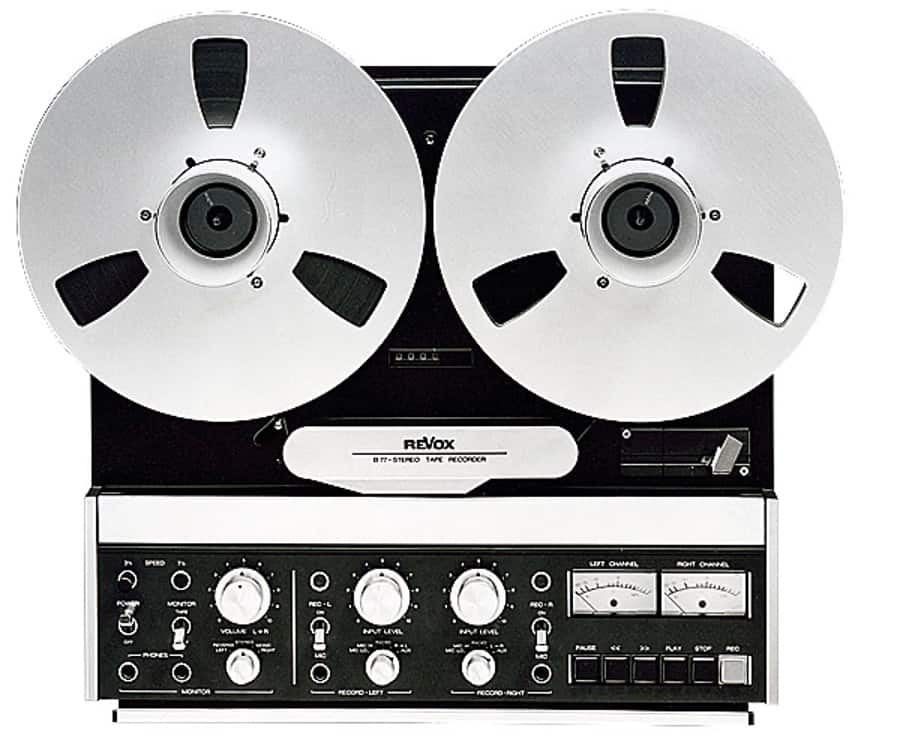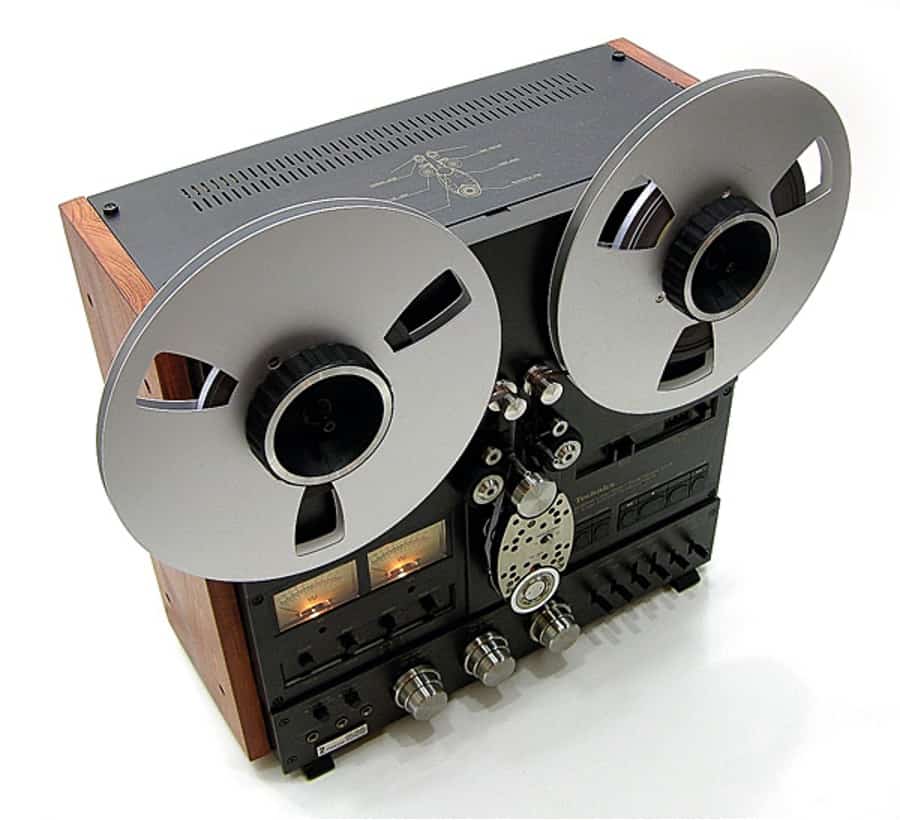
by Martin Colloms, First Published HiFi News, June 1978
The last year or so has seen the emergence of a new generation of high-quality open-reel tape decks, of which four are investigated here. As the price span ranges from £500-£600 for the Sony and Revox models to £850 for the Technics and £950 for the basic Pioneer assembly, these units are not strictly comparable, although their relative performances are nonetheless interesting.
All four recorders subscribe to the ‘professional’ format, namely a 26.5cm diameter maximum reel capacity with at least two high speeds (19 and 38cm/sec), and a two-channel half-track format on 6.25mm (¼in) tape. However, strictly speaking they should be called ‘semi-professional’, as although they are essentially capable of master quality recordings, they do differ from true studio machines in several respects. For example, the input and output connections of professional machines are generally balanced-line with Cannon or similar type sockets. In contrast, the review models are all unbalanced, with phono and DIN-type inputs and outputs, plus lower line levels.
The Revox B77 reviewed is the ‘high speed’ version with IEC equalisation, while the Pioneer deck may be switched to operate in either IEC or NAB record/playback EQ standards at the higher speed. The Technics and Sony are both fixed in NAB. (IEC equalisation allows a little more treble boost on record than NAB, while the consequent relative reduced treble on replay endows the IEC machine with a couple of decibels less replay hiss.)
Both Technics and Sony decks have a second built-in replay head which allows the replay of ¼-track stereo tapes, which is an important point for the purchaser with an established tape library. The Pioneer will also play ¼-track tapes, but less conveniently via the interchange of complete head-block assemblies. But this substitution also allows the deck to record in the ¼-track format and, indeed, if a second preamp/control unit is employed, full four-track, four-channel working is possible with the Pioneer model. Versatility is clearly the keynote of this unusual recorder.
All the decks have solid-state or full relay control of transport functions, with the required modes selected by light-action buttons that are duplicated, if required, by cable-connected remote control units. The delayed logic systems incorporated also allow sequential and random actuation of any function except ‘record’ (for which the usual interlocks are provided), without confusion or any tape mishandling. Other common features include a basic system design for vertical operation, although the decks can be used horizontally. However, the controls, tape paths and meter systems are all most accessible to hand and eye if the machines are vertically positioned on a rack or shelf of convenient height.
Other points common to all four machines are features now taken for granted with high-quality decks. For example, a three-motor transport, one for each reel in addition to the capstan. Three magnetic heads are also employed – erase, optimum record and an optimum replay. Good tape handling goes almost without saying, and all have tape back-tension switches to allow for small-core reels; the exception to this is the Technics deck, whose special tensioning will accommodate these.

Designated individually as the RTU11 tape transport and TAU11 amplifier units, together this dual combination is called the RT2022. Without factory modification or lab alignment this deck can, with an additional head-block and control amplifier, perform in stereo/mono record or playback modes, ½- or ¼-track format; four-channel play/record with ¼-track; NAB equalisation at 19cm/sec and 38cm/sec speeds; IEC equalisation at 38cm/sec, with cross-dubbing, echo, multi-track and sound-on-sound.
To aid multi-tracking, the record heads may also be used for monitoring to allow accurate synchronisation of the second track. Furthermore, several self-correction features are built into the transport section. A test oscillator with 1kHz and 10kHz tones allows selection of optimum tape equalisation and bias settings, this oscillator together with the bias settings being adjustable from the front panel, protected by a removable smoked Perspex cover.
For four-channel operation the second TAU11 unit clips beneath the first by means of tensioned latches, with recesses provided in the top panels to stow the interconnecting cables. Almost every input and output socket is duplicated, and when the four-channel system is fully assembled the rear resembles a telephone exchange! However, Pioneer has thoughtfully supplied colour-coded cables so that links may readily be traced. What’s more, several inputs and outputs are also brought forward to the front panel by means of jack cables, in order that supplied signals may be quickly routed from one track to another.
Mechanically, the deck is robustly constructed with a die-cast frame and a 5mm-thick machine alloy main bed-plate. Two eddy/induction hybrid reel motors are used, plus a hysteresis synchronous capstan motor driving the flywheel via a resilient belt. Damped tension arms smooth the tape transport and the heads maintain contact with the tape by back-tension alone. A flutter roller is also incorporated. Finally, the deck’s side panels are finished in black leatherette though their appearance, reinforced by the massive carrying handle and chrome latch fittings, visually suggests location recording rather than a domestic hi-fi installation.

The successor to the A77, the B77 represents a development of the older model rather than an entirely new design. A number of changes have been made, significant enough to say at the outset, that while I had considerable respect for the A77, I did not personally favour certain aspects of its performance, notably poor level matching, premature overload of electronics and poor control ergonomics. However, all these have been resolved in the new model, as well as refinements made.
For example, the capstan motor – the famous direct-drive tachogenerator design – has been further developed and is now closer to that of the Revox A700. The deck will also accept an accessory that allows fine control of capstan speed and hence of musical pitch, when required. Improvements to head quality have resulted in increased life as well as a more uniform frequency response, and the transport section has now eliminated those occasionally troublesome relays, with their function now carried out by semiconductors, bringing an expected increase in reliability.
In addition to all the basic features, certain more specialised functions are included in this deck, their use facilitated by a clear instruction manual and internal switch connections. For instance, as well as the edit button, which allows the tape to be brought into contact with the heads for manual and powered location of edit points, a splicer is also built into the front deck plate. Very comprehensive input and monitor source selections are also possible, such as those permitting switched transfer of the replay of one channel onto record of the next, with simultaneous mixing of flutter-echo effects, sound-on-sound, and overdub material from other inputs, including microphone.
Meanwhile, two headphone sockets are provided, with adequate levels to drive high impedance ‘orthodynamic’ types as well as the more sensitive moving-coil varieties. A headphone volume control (monitor level) is present, although the line outputs are semi-fixed (preset controls can be found on the rear panel). Finally, the level meters sensibly indicate the modulation depth going onto or coming off the tape, and are not affected by replay level adjustment.

A substantial machine of excellent finish and with a ‘solid’ feel, the TC766-2 employs the company’s established dual-capstan tape transport which isolates the section of tape passing over the heads from most reel tension irregularities. The tape path itself is complex, with damped tension arms, rollers and fixed guides, and some practice is required for quick threading. The latter is also impaired to some degree by the high static back-tension. The two capstans have individual flywheels, both belt-driven from one AC-powered servo-controlled motor using a tacho generator. The feed spool motor is also servo-controlled to maintain optimum back-tension.
One further change is that the latching transport switches on earlier Sony models have here been replaced by illuminated touch buttons, with full logic control, and a minimum of relays, with AC motor switching, etc, now being accomplished by way of bridge-linked transistor controls.
Sony’s own ferrite magnetic heads are used on the TC766-2, these carrying the ‘Symphase’ label which indicates that special attention has been paid to phase balance at high frequencies between tracks. This is vital to matrixed programmes but also important in stereo. The low wear rate of these heads means that theoretically they could last out the life of the machine.
One final point is that with a large in-house tape manufacturing plant in Japan as well as the USA, it is perhaps not surprising that the TC766-2 is compatible with Sony’s latest open-reel tape FeCr or ‘Dual’, and while this has yet to be fully investigated, it would appear to offer extended dynamic range not to mention low distortion.

This award-winning recorder demonstrates Technics’ expertise in the field of direct-drive motors. In fact, the transport is reminiscent of an established ‘3M’ professional deck, with a looped ‘U’ tape path over the heads isolated from the feed and take-up reels by a large capstan as well as a dual pinch-wheel system. The motors of course differ, the Technics capstan being a quartz frequency controlled unit with a massive integral flywheel. This is the tape deck equivalent of the SP10 Mk II motor used in the turntable of the same name.
The precise speed control plus minimal tape slip allows this deck to be fitted with an elapsed-time-indicator scaled in minutes and seconds – a marked improvement over the arbitrarily scaled tape position counters usually employed. In addition, a variable pitch option is included on the front panel.
The Technics RS-1500 US is also equipped for direct DC operation from an external 24V supply – for example, two car batteries or a 24V NiCad pack – although some limitation on excessive fast winding is apparent in this mode, and the panel lamps are also disconnected to conserve energy.
As with the Sony deck, the reel motors are servo-controlled, and in addition the RS-1500 US roller bearing tension arms are air-piston damped. In consequence, the deck attains a stable operating speed in under one second from start-up. The closed tape-loop also allows a relatively low tension value (80g), which minimises scrape flutter (mechanical modulation noise) at the same time serving to maintain excellent tape/head contact.
All four machines in this group performed very well so the decision to purchase must be based on a dual consideration of price, plus facilities offered. At approximately £500, the Sony TC766-2 is undoubtedly good value. The points to note are fine performance at both speeds, facilities for FeCr tape plus NAB equalisation. The deck was also accurately calibrated in all respects and showed minimal response irregularities at low frequencies. However, some mechanical noise was apparent.
At a higher price (£600) the Revox B77 represents equally good value, with excellent responses, particularly at low frequencies. It is also comparatively quiet. With IEC equalisation it offers the best dynamic range at 38cm/sec, and the peak modulation indicators are useful. Build quality is high, with excellent accessibility for servicing.

The Technics RS-1500 US sells for around £850. As well as its excellent all-round performance, its outstanding transport offers a superlative tape-head contact and gentle tape handling. A 9.5cm/sec speed is included for less demanding applications, and ¼-track replay is also part of the package. NAB equalisation and a Varispeed capstan are standard, as is the quartz lock which makes a genuine elapsed-time tape meter possible, and the option for DC operation is also unique here.
In two-channel form, the Pioneer RT2022 costs £900, with an extra £250 bringing you the second four-channel head-block along with the additional record amplifier control unit. As a system it has no contemporary parallel and would suit a serious amateur music enthusiast, while the RTU11 on its own (which costs around £800) could be used alone as a replay/calibration transport with IEC and NAB equalisation available at 38cm/sec.
In addition to the system’s sheer versatility and fine overall performance, special features include its in-built calibration oscillators, wide-range metering and a rugged but straightforward mechanical construction. Used exhaustively for a number of recent large group tests as a master tape replay source, this deck has proved dependable. At around £1150 in four-channel form, and taking into account all the facilities offered, the value is good.
Martin Colloms 1978 for HiFi News (Note: half a century ago HiFi News did not allow comment on sound quality)
Return to HIFICRITIC News
© Copyright 2024 Martin Colloms | Terms of Use | Privacy Policy | Cookies | Contact